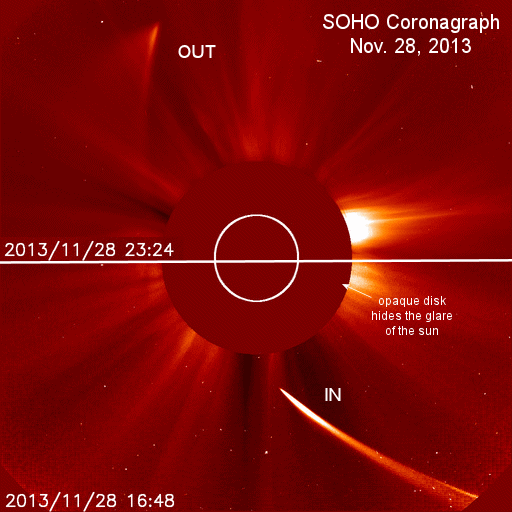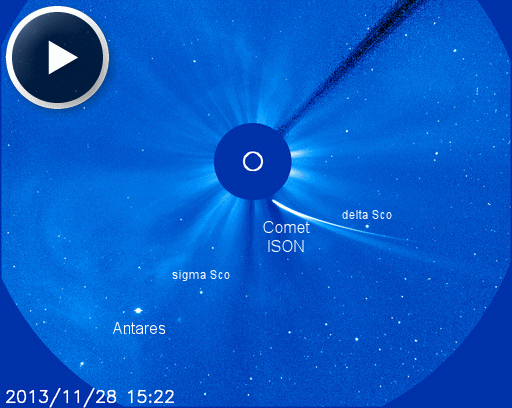CANCEL THE EULOGY: Comet ISON flew through the sun's atmosphere on Nov. 28th and the encounter did not go well for the icy comet. Just before perihelion (closest approach to the sun) the comet rapidly faded and appeared to disintegrate. This prompted reports of ISON's demise. However, a fraction of the comet might have survived.
Click on the image below to see what emerged from Comet ISON's brush with solar fire:
Click on the image below to see what emerged from Comet ISON's brush with solar fire:
In the movie, Comet ISON seems to be falling apart as it approaches the sun. Indeed, researchers working with NASA's Solar Dynamics Observatory said they saw nothing along the track that ISON was expected to follow through the sun's atmosphere. Nevertheless, something has emerged. Whether this is a small scorched fragment of Comet ISON's nucleus or perhaps a "headless comet"--a stream of debris marking the remains of the comet's disintegrated core--remains to be seen.
An earlier movie from SOHO shows more of the comet's approach:
The movie spans a day and a half period from Nov. 27th (01:41 UT) to 28th (15:22 UT). We see that Comet ISON brightened dramatically on Nov. 27th before fading on Nov. 28th. That brightening might have been a disintegration event, in which the comet cracked open and spilled its vaporizing contents into space. SpaceWeather
Comet ISON is down, but not out!
From: EarthSky
NOVEMBER 28, 2013. It has been … a ride. Comet ISON rounded the sun today at 18:45 UTC/ 1:45 p.m. ES, and appeared to be disintegrating. Now this evening the comet is appearing brighter again. Will some remnant be visible from Earth in early December, as ISON pulls away from the solar glare? It hardly seems likely at this point that we’ll get a very bright comet. But we might get something. And, whatever happens now, hasn’t it been great so far?
By Thursday evening, at least one scientist – Karl Battams at NASA’s Comet ISON Observing Campaign – wrote on Twitter:
Alright we’re calling it, and you heard it here first: We believe some small part of #ISON’s nucleus has SURVIVED perihelion.
The bad news about ISON came earlier today. Karl Battams – who has almost singlehandedly informed the world about this comet – wrote shortly before perihelion:
Last night [Nov. 27], I was optimistic that comet ISON would continue its dramatic brightening trend, and soar into the negative magnitudes. This morning it is indeed with a heavy heart that I show you the image [above], in which we clearly see that ISON has faded rather dramatically in the past few hours. It is still likely around -1 magnitude, but this number is falling fast.… and now I’m reluctantly thinking it seems very unlikely to survive at this point. I do think it will reach perihelion, and reach the NASA SDO field of view, but based on what I see it doing right now, I will be very surprised to see something of any consequence come out the other side.BUT… at every single opportunity it can find, Comet ISON has done completely the opposite of what we expect, and it certainly wouldn’t be out of character for this dynamic object to again do something remarkable.


